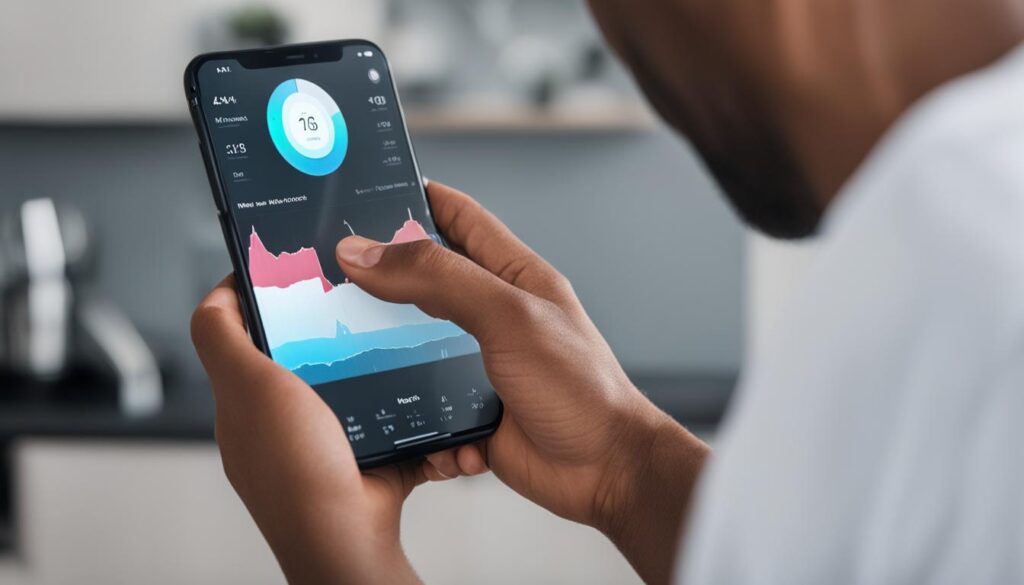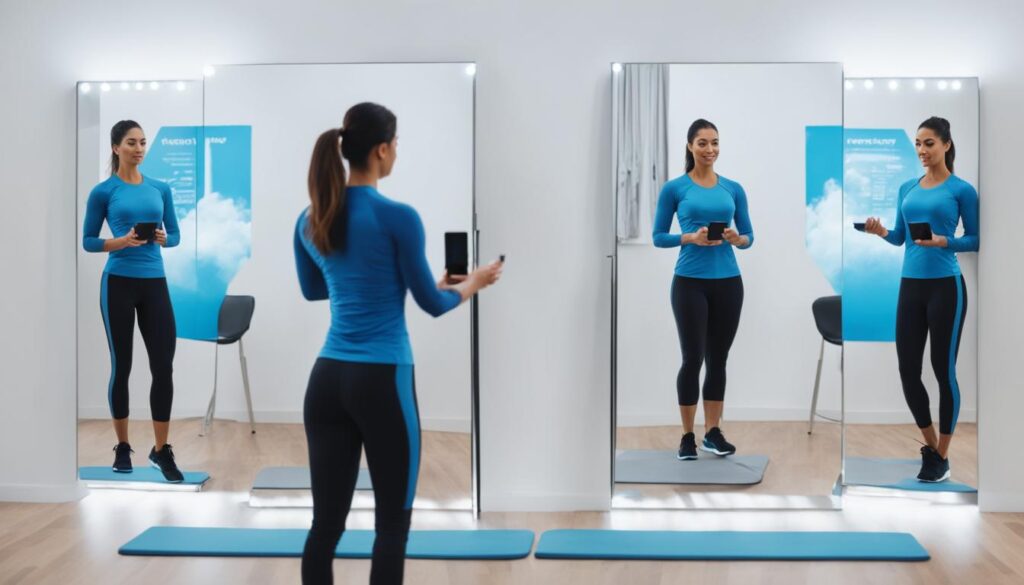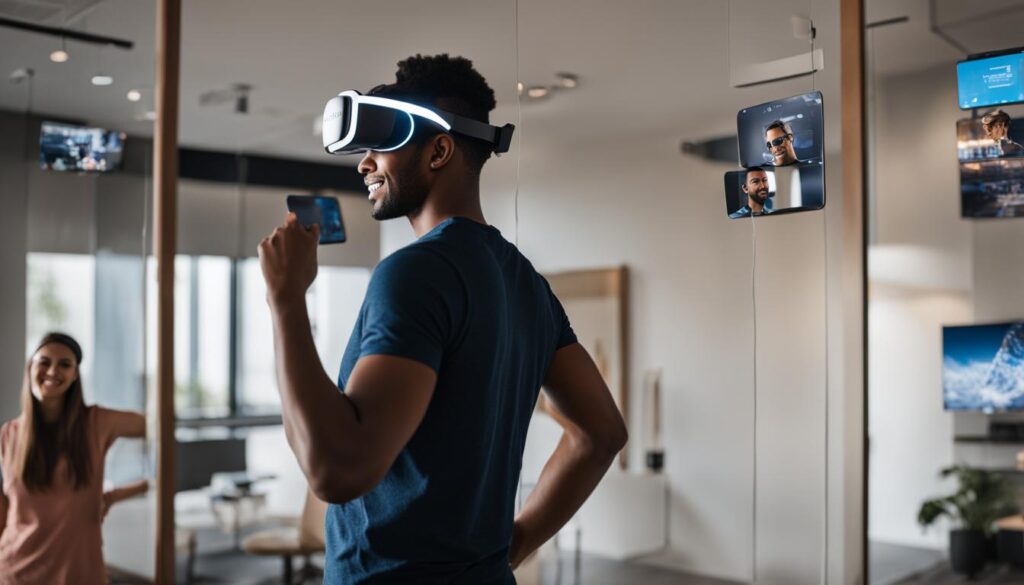In today’s rapidly advancing technological landscape, augmented reality (AR) is emerging as a powerful tool with the potential to transform behavior change. AR has the unique ability to overlay virtual content onto the real world, creating immersive and interactive experiences that can influence behavior and support behavior modification. As researchers at Stanford have discovered, the impact of AR on behavior change is profound.
In a groundbreaking study, participants who wore AR goggles and experienced virtual content placed in their real-world environment exhibited significant changes in their behavior, even after the AR device was removed. The presence of virtual objects or people had a similar influence on participants as real-world interactions, indicating that AR has the potential to shape and modify behavior on a large scale.
Major companies are already developing AR technology that offers realistic virtual meetings, reducing the need for commuting or traveling for meetings. This not only has the potential to save time and resources but also contributes to behavior change by promoting sustainable practices. AR can be a game-changer in addressing social and environmental issues, as it offers innovative solutions that can revolutionize behavior management and improvement.
Contents
- 1 Influence of AR on Social Behavior
- 2 Potential Applications of AR in Behavior Support
- 3 Augmented Reality in Education and Learning
- 4 The Potential of AR in Therapy and Rehabilitation
- 5 The Role of AR in Personal Development
- 6 Conclusion
- 7 FAQ
- 7.1 How can augmented reality (AR) help with behavior change?
- 7.2 What is the influence of AR on social behavior?
- 7.3 What are the potential applications of AR in behavior support?
- 7.4 How can augmented reality enhance education and learning?
- 7.5 How can AR be used in therapy and rehabilitation for behavior change?
- 7.6 What role does AR play in personal development?
- 7.7 What are the benefits of using AR for behavior management?
- 8 Source Links
Key Takeaways:
- AR has the potential to shape and modify behavior by overlaying virtual content onto the real world.
- Participants in a Stanford study exhibited significant behavior changes after experiencing AR.
- AR technology can offer realistic virtual meetings, reducing the need for commuting.
- AR has the potential to address social and environmental issues by promoting sustainable practices.
- AR is an innovative tool for behavior management and improvement.
Influence of AR on Social Behavior
The advent of augmented reality (AR) has brought about significant changes in various aspects of human behavior. Researchers at Stanford conducted a study to understand how AR impacts social interactions and interpersonal dynamics.
During the study, participants were exposed to AR experiences that involved interacting with virtual avatars. The findings revealed that when individuals engaged with virtual avatars in AR, they exhibited social inhibition similar to real-world contexts where someone feels watched. The virtual avatars had a noticeable influence on the participants’ behavior and their performance on tasks.
Moreover, the study revealed that wearing AR headsets during conversations led to a decrease in social connection between the participants. This suggests that AR can have a profound impact on social behavior and interpersonal dynamics.
By providing virtual overlays onto the real world, AR has the potential to shape and improve behavior. These findings highlight the role of AR in behavior shaping and its potential to enhance social skills.
The Role of AR in Behavior Shaping
AR technology offers unique benefits when it comes to behavior change and improvement. Here are some key aspects of AR’s role in behavior shaping:
- Enhanced Social Behavioral Skills: AR experiences can simulate social scenarios and provide individuals with opportunities to practice and refine their social skills. By interacting with virtual avatars, users can develop more effective communication strategies and learn how to navigate social interactions.
- Real-Time Feedback and Guidance: AR can provide individuals with immediate feedback on their behavior, allowing them to make adjustments and improve their actions in real-time. This real-time guidance can be especially effective for learning and behavioral change.
- Visual Cues and Prompts: Through AR, visual cues and prompts can be strategically integrated into the environment to support behavior change. For example, AR can display reminders or step-by-step instructions for performing specific actions, reinforcing positive behaviors.
- Immersion and Engagement: The immersive nature of AR can captivate individuals and enhance their engagement in behavior change interventions. By creating a realistic and interactive environment, AR experiences can motivate individuals to actively participate in their own behavior improvement.
Overall, the role of AR in behavior shaping is promising, as it offers innovative ways to enhance social skills, provide real-time guidance, and create immersive experiences that drive behavior change.
| Benefits of AR in Behavior Change | Description |
|---|---|
| Enhanced Social Behavioral Skills | AR experiences allow individuals to practice and refine their social skills in a controlled virtual environment. |
| Real-Time Feedback and Guidance | AR provides immediate feedback on behavior, helping individuals make real-time adjustments for improvement. |
| Visual Cues and Prompts | AR can display visual reminders and step-by-step instructions, supporting behavior change through visual cues. |
| Immersion and Engagement | The immersive nature of AR motivates individuals to actively engage in behavior change interventions. |
Potential Applications of AR in Behavior Support
Augmented reality (AR) technology holds immense potential in supporting behavior change and enhancing personal development. By leveraging AR interventions, individuals can benefit from visual cues, real-time feedback, and immersive experiences that facilitate behavior enhancement. Let’s explore some of the exciting applications of AR in behavior support:
1. Visual Cues and Prompts
AR can provide individuals with step-by-step instructions and visual cues to support behavior change. For example, imagine using AR goggles to overlay instructions on how to perform a specific task, guiding you through each step in real-time. This visual guidance can enhance learning and reinforce positive behaviors, making behavior change more accessible and engaging.
2. Gamification for Reinforcing Positive Behaviors
AR applications can incorporate gamification elements to reinforce positive behaviors. Imagine earning virtual rewards or completing challenges in an augmented environment to encourage and motivate behavior improvement. Gamifying behavior change through AR can make the process more enjoyable and increase engagement.
3. Real-Time Feedback and Monitoring
AR technology enables real-time feedback and monitoring of behavior. Individuals can track their progress, receive instant feedback, and make necessary adjustments to their behavior. This feedback loop empowers individuals to take an active role in their behavior change journey, enhancing their ability to achieve their goals.
4. Simulating Real-World Scenarios
In therapy and rehabilitation settings, AR can be used to simulate real-world scenarios, providing individuals with immersive experiences for behavior change. For instance, AR can recreate social situations to help individuals develop social skills and overcome social anxiety. By practicing in a safe and controlled virtual environment, individuals can build confidence and transfer learned behaviors to real-life situations.
5. Supporting Personal Growth and Development
AR technology can play a significant role in personal development by providing personalized and immersive experiences. By overlaying virtual information onto the real world, AR can offer new perspectives and insights into behavior, enabling individuals to gain self-awareness and identify areas for improvement. With real-time guidance and feedback, AR can support individuals in achieving their personal growth goals.
By tapping into the potential of AR interventions for behavior support, individuals can embark on a transformative journey of self-improvement and wellness. The versatility and immersive nature of AR technology offer innovative approaches to behavior enhancement and personal development.

| Application | Description |
|---|---|
| Visual Cues and Prompts | AR provides step-by-step instructions and visual cues to support behavior change. |
| Gamification for Reinforcing Positive Behaviors | AR incorporates gamification elements to reinforce positive behaviors. |
| Real-Time Feedback and Monitoring | AR enables real-time feedback and monitoring of behavior. |
| Simulating Real-World Scenarios | AR simulates real-world scenarios to provide immersive experiences for behavior change. |
| Supporting Personal Growth and Development | AR supports personal development by providing personalized and immersive experiences. |
Augmented Reality in Education and Learning
Augmented reality (AR) has emerged as a powerful tool for behavior change in the field of education and learning. By providing interactive and immersive experiences, AR engages students on a whole new level, promoting active participation and facilitating behavior modification.
One of the key advantages of AR in education is its ability to create realistic simulations and virtual environments. Students can practice skills and apply knowledge in a context that closely resembles real-world scenarios. For example, medical students can simulate surgeries and other procedures using AR, allowing them to gain hands-on experience and develop the necessary skills in a safe and controlled environment.
AR also enhances the learning experience in subjects such as science and history. Students can explore virtual representations of scientific concepts or historical events, making the learning process more engaging and memorable. Whether it’s witnessing the formation of atoms or stepping into the shoes of historical figures, AR brings learning to life.
By utilizing AR technology, educators can create transformative learning experiences that promote behavior change and skill development. AR provides visual and interactive cues that keep students actively engaged, encouraging them to take ownership of their learning journey. The immersive nature of AR captivates students’ attention and fosters a deeper understanding of the subject matter.

The Benefits of Augmented Reality in Education
There are several benefits of incorporating AR into education:
- Increased student engagement and motivation: AR captures students’ interest and encourages active participation, leading to improved learning outcomes.
- Enhanced understanding of complex concepts: AR provides visual and interactive representations that help students grasp abstract or complex concepts more easily.
- Real-world application of knowledge: AR simulations allow students to apply their knowledge in practical scenarios, preparing them for real-life situations.
- Personalized and adaptive learning experiences: AR can be tailored to individual students’ needs, providing personalized feedback and support for their unique learning styles.
Harnessing the Power of AR for Behavior Change in Education
AR technology has the potential to revolutionize education by creating immersive and interactive learning experiences that promote behavior change and skill development.
Through AR, education transcends traditional boundaries, unlocking new possibilities for behavior change and personal growth. By leveraging the power of augmented reality, educators can propel their students towards a brighter future.
The Potential of AR in Therapy and Rehabilitation
Augmented reality (AR) has shown promising applications in the field of therapy and rehabilitation, particularly in supporting behavior change. AR can provide immersive and interactive experiences that facilitate behavior change in therapeutic interventions.
One significant application of AR is in exposure therapy, where individuals gradually confront and overcome their fears. By simulating anxiety-provoking situations in a controlled and safe environment, AR provides a virtual representation of feared stimuli. This approach allows individuals to work through their fears in a gradual and supportive manner, leading to lasting behavior change.
In addition, AR can be utilized in rehabilitation settings to enhance motivation and engagement in therapy. By providing visual and auditory cues, AR can support motor skill development. The immersive nature of AR creates a powerful tool for behavior change, as it encourages individuals to actively participate in their rehabilitation process and helps them achieve their therapy goals.
Case Study: AR in Exposure Therapy
“Using augmented reality in exposure therapy has revolutionized the way we treat anxiety disorders. By creating virtual scenarios that mimic real-life situations, we can provide a safe and controlled environment for patients to confront their fears. The immersive experience of AR helps individuals overcome their anxiety and develop healthier coping mechanisms.”
Benefits of AR in Therapy and Rehabilitation
| Benefits | Examples |
|---|---|
| Enhanced motivation | AR provides a captivating and interactive experience, increasing motivation in therapy sessions. |
| Safe and controlled environment | AR allows individuals to face their fears in a virtual environment, minimizing risks and ensuring a controlled setting. |
| Personalized interventions | AR can be tailored to individual needs, providing customized experiences that target specific behaviors. |
| Real-time feedback | AR offers immediate visual and auditory feedback, enabling individuals to make adjustments to their behavior in real-time. |
The Role of AR in Personal Development
Augmented reality (AR) can be a powerful tool for personal development and behavior change. By leveraging AR technology, you can immerse yourself in personalized experiences that promote self-reflection and self-awareness. With AR, you can gain new perspectives and insights into your behavior and actions, which can be instrumental in enhancing your behavior and personal growth.
One of the key benefits of AR is its ability to overlay virtual information onto the real world, allowing you to see things from a different vantage point. This increased self-awareness can help you identify areas for improvement and set goals for behavior change. Whether it’s breaking bad habits, improving communication skills, or fostering positive attitudes, AR can provide the guidance and motivation you need to make meaningful transformations.
AR also offers real-time feedback and guidance, enabling you to track your progress and make adjustments to your behavior. The interactive nature of AR allows for engaging and immersive experiences, making the learning and development process more enjoyable and effective.
Enhancing Self-Reflection and Self-Awareness
Through AR, you can visualize your actions and behaviors in real-time, allowing for immediate self-reflection and analysis. By seeing yourself from an objective standpoint, you can gain deeper insights into your behavior patterns and their impact on your daily life. This increased self-reflection and self-awareness can empower you to make conscious choices and adjustments that align with your personal values and goals.
Setting Goals and Tracking Progress
AR can assist you in setting goals and tracking your progress towards behavior change. By visualizing your goals in augmented reality, you can create a compelling and motivating vision for yourself. AR also enables you to monitor your progress in real-time, providing feedback and guidance along the way. This feedback loop helps you stay accountable and make the necessary adjustments to reach your desired outcomes.
Immersive Learning Experiences
AR facilitates immersive learning experiences that promote behavior change. By simulating real-world scenarios, AR allows you to practice new behaviors and skills in a safe and controlled environment. This hands-on approach enhances the learning process and increases the likelihood of successful behavior modification. Whether you’re practicing public speaking, honing negotiation skills, or developing leadership qualities, AR can provide a dynamic learning environment that accelerates your personal development journey.
Overall, augmented reality has the potential to revolutionize personal development by providing personalized, immersive, and interactive experiences that enhance behavior change. Through AR, you can embark on a transformative journey of self-discovery, learn new skills, and become the best version of yourself.

| Benefits of AR in Personal Development | |
|---|---|
| Enhances self-reflection and self-awareness | Gain new perspectives and insights |
| Facilitates goal-setting and progress tracking | Stay motivated and accountable |
| Provides immersive learning experiences | Practice new behaviors and skills |
Conclusion
Augmented reality (AR) technology has the potential to revolutionize behavior change by providing immersive and interactive experiences that shape and modify behavior.
AR has shown promising applications in various fields such as social behavior, education, therapy, and personal development. By overlaying virtual content onto the real world, AR can influence and support behavior change through visual cues, feedback, and simulations.
AR interventions can be designed to provide personalized and engaging experiences that facilitate behavior change and enhance learning and development. The possibilities for using AR in behavior management and improvement are vast, offering exciting opportunities for individuals to enhance their lives and achieve their goals through augmented reality technology.
FAQ
How can augmented reality (AR) help with behavior change?
Augmented reality has the potential to shape and modify behavior by providing immersive and interactive experiences. AR interventions can offer visual cues, step-by-step instructions, real-time feedback, and simulations to support behavior change and improvement.
AR can have a significant impact on social behavior and interpersonal dynamics. Interacting with virtual avatars in AR can result in social inhibition and affect participants’ behavior and performance on tasks. Additionally, wearing an AR headset can reduce social connection with conversation partners.
What are the potential applications of AR in behavior support?
AR can be used in behavior support to provide visual cues and prompts, reinforce positive behaviors through gamification, and offer real-time feedback and monitoring. AR also has potential applications in therapy and rehabilitation settings for simulating real-world scenarios and providing immersive experiences for behavior change.
How can augmented reality enhance education and learning?
Augmented reality can enhance education and learning by providing interactive and immersive experiences. AR can create simulations and virtual environments that engage students and allow them to practice skills and apply knowledge in a realistic context, making it a powerful tool for behavior change and skill development.
How can AR be used in therapy and rehabilitation for behavior change?
AR can be used in therapy and rehabilitation to provide immersive and interactive experiences that facilitate behavior change. It can simulate anxiety-provoking situations for exposure therapy and provide visual and auditory cues for motor skill development. AR can also enhance motivation and engagement in therapy.
What role does AR play in personal development?
Augmented reality can support personal development by offering immersive and personalized experiences for self-reflection and self-awareness. AR overlays virtual information onto the real world, providing new perspectives and insights into behavior and actions and offering real-time feedback and guidance for behavior change.
What are the benefits of using AR for behavior management?
Using AR for behavior management offers personalized and engaging experiences that can shape and modify behavior. It provides visual cues, feedback, and simulations for behavior change, supports learning and skill development, and offers innovative approaches to support personal growth and development.




